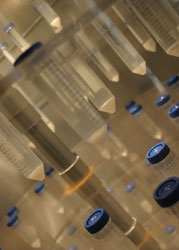High density gene map for the fruit fly
Unravelling the human genome relies heavily on functional genomic studies in Drosophila. Project partners of FLYSNP focused on the production of a fine-resolution genome map to facilitate the assignment of functions to any given gene. Single nucleotide polymorphisms (SNPs), or genetic variants that are different in respect of one nucleotide only, occur very frequently in D. melanogaster. Due to their high incidence and their phenotypic expression, they are highly suitable for use as markers for mutations. These mutations, once located, can then be cloned for further study. A team at the Austrian Academy of Sciences in Austria created a high-density SNP map with over 2000 markers. Importantly, these are widely and evenly spaced throughout the genome. Construction of the SNP map was achieved in three phases, from an initial low-density to a medium and then the high-density map. To achieve this, they utilised the Drosophila genetic database, FlyBase for comparison of the SNPs that were selected, sequenced and amplified. Automatic SNP detection by the PolyBayes software package was followed by the application of quality criteria and then visual inspection of the alignments to increase reliability. For interested users, the SNP map is shown via the project database at http://flysnp.imp.ac.at/flysnpdb.php Here, there is an introduction to the project, a user guide, methods, and links to important relevant sites. Information downloadable from the website on specified regions includes the alleles, position in the genome (arm region and position), flanking sequences and details of the amplification primers. There is also a direct link through GBrowse that gives a pictorial version of sequences. The work achieved by the team has developed the SNP mapping technique which has cut the onerous task of mapping from years in some cases, to a matter of a few months. This allows researchers to concentrate their valuable time on further analysis of the genes and location of new mutations.







